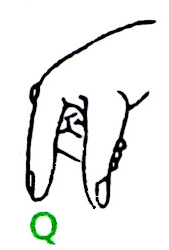Q
![]()
This article deals mainly with the origin, representation and pronunciation of the letter Q. For the various meanings of this character, see Q (disambiguation).
Q or q (pronounced: in Germany and Switzerland [kuː]; in Austria generally [kveː], in mathematics [kuː]) is the 16th letter of the Classical and the 17th letter of the Modern Latin alphabet. It denotes a consonant. In most languages, except for proper names, the Q occurs only in the digraph QU; in German, this letter combination has the phonetic value /kv/. The letter Q has an average frequency of 0.02% in German texts and is thus the rarest letter in German texts.
The "tail" or "tail" of the letter Q is technically called the cauda.
The finger alphabet for the deaf or hard of hearing represents the letter Q with the index finger and thumb pointing down and the remaining fingers resting on the palm.

Letter Q in the finger alphabet
Origin
|
|
|
|
|
|
| Protocanaanian Qoph symbol | Phoenician Qoph | Early Greek Qoppa | Etruscan Q | Latin Q |
Whether the letter already appeared in the Proto-Sinaitic script is disputed. If so, the early form of Q is probably a symbol that looks like an 8. The earliest antecedent identified with certainty is the letter Qoph in the Phoenician alphabet. This letter already has strong similarities to the Latin Q. As a reason for the appearance of the Qoph, there are two theories: Based on the acrophonic principle, the letter could, according to its name (qoph means "monkey"), represent the dorsal view of a monkey, the stroke its tail. Another possibility would be that the symbol represents a human head with a neck. Among the Phoenicians, Kof had the phonetic value /q/ for the voiceless uvular plosive. The sound of [q] corresponds to a k, which is pronounced in the throat (at the uvula).
The Greeks adopted the letter as qoppa in their alphabet and changed it so that the vertical line was no longer continuous. Since Greek did not contain the sound /q/, they used the qoppa for the /k/ sound before the back vowels /o/ and /u/, while writing /k/ before the other vowels with kappa. Because two letters for one phoneme proved redundant, the qoppa was abolished early and remained in use only as a numeral sign for 90.
When the Etruscans adopted the Greek alphabet, the qoppa was still in use and was thus also adopted in the Old Italian alphabet. The letter V could have the phonetic value /β/ as well as /u/ among the Etruscans, and the Etruscan language contained both phonetic sequences /kβ/ and /ku/. In order to distinguish between them, the Etruscans, following Greek practice, used the letter Q to render /k/ before /u/ (there was no /o/ in Etruscan). In addition to the K, which was used before /a/, and the C, which originated from the Greek gamma (Etruscan did not know voiced consonants), which was used before /e/ and /i/, Etruscan thus also had a third letter with the phonetic value /k/.
Through Etruscan mediation, the Q also entered the Latin alphabet, only the lower stroke moved to the right over time. In the beginning, the Etruscan practice was followed and, for example, PEQUNIA was written for pecunia ("money"). Later, the /k/ was written with C only. The Q, however, was retained in the letter combination <QV> (= <QU>) in order to be able to write the sound [kʷ]. This had emerged from the Urindo-European labiovelar and in Latin represented not simply a compound of [k] and [w], but a phoneme in its own right. As can be seen, among other things, from the metrical rules of poetry, the [kʷ] was also understood as an independent sound. It was therefore logical to use a special spelling for it. Thus, qui [kʷiː] ("who") could be distinguished from cui [ˈkui] ("whom").
Usage
In many languages written with the Latin alphabet, the grapheme <QU> for <KV> or <KW> has been preserved for historical reasons, although it is not an independent phoneme in these languages. In German, the digraph <QU> is pronounced as [kv], and in many other languages, such as English as [kw]. In some Romance languages (French, Spanish, Portuguese), <QU> is used for the /k/ sound before the front vowels /e/ or /i/ (example: Québec).
In various languages, the Q can also occur without a following U. In the orthography of Albanian, the Q has stood for the voiceless palatal plosive [c] since 1908. In the pinyin transcription used for Chinese, the Q stands for the affricate [tɕʰ]. In the International Phonetic Alphabet (IPA), the grapheme denotes the voiceless uvular plosive [q], following the Phoenician qoph. In some modern alphabets of non-European languages, the letter Q is used for this sound, as in Quechua, Aymara, Quiché, and Greenlandic (Kalaallisut). In the transcription of Arabic, the Arabic Qaf, which also goes back to the Phoenician Qoph and has the same phonetic value, is sometimes rendered as Q (e.g. "Qalam"). In Somali, Q denotes the voiced uvular plosive, and in Maltese, a glottal stop. In some southern African languages (e.g. Zulu and Xhosa), a Q represents a click sound.
Search within the encyclopedia


